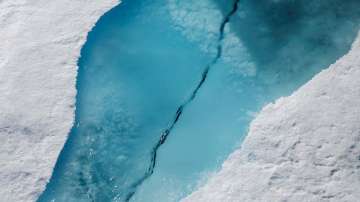Human-caused climate change is on track to make the Arctic Ocean functionally ice-free for part of each year starting sometime between 2044 and 2067, according to a study. Researchers at the University of California, Los Angeles (UCLA) in the US noted that as long as humans have been on Earth, the planet has had a large cap of sea ice at the Arctic Circle that expands each winter and contracts each summer.
Satellite observations show that since 1979, the amount of sea ice in the Arctic in September -- the month when there is the least sea ice, before water starts freezing again -- has declined by 13 per cent per decade, the researchers said.
Scientists have been attempting to predict the future of Arctic sea ice for several decades, relying on an array of global climate models that simulate how the climate system will react to all of the carbon dioxide entering the atmosphere.
However, the models' predictions have disagreed widely, according to the study published in the journal Nature Climate Change.
Among the current generation of models, some show ice-free Septembers as early as 2026, while others suggest the phenomenon will begin as late as 2132.
The study's lead author, Chad Thackeray, an assistant researcher at UCLA, said one reason predictions about sea ice loss diverge so much is that they differ in how they consider a process called sea ice albedo feedback.
The process occurs when a patch of sea ice completely melts, uncovering a seawater surface that is darker and absorbs more sunlight than ice would have.
That change in the surface's reflectivity of sunlight, or albedo, causes greater local warming, which in turn leads to further ice melt, the researchers said.
The cycle exacerbates warming -- one reason the Arctic is heating up twice as fast as the rest of the globe, they said.
Thackeray and co-author Alex Hall, a UCLA professor, noted that sea ice albedo feedback not only happens over long periods of time due to climate change, but also happens every summer when sea ice melts for the season.
Satellite observations over the past few decades have tracked that seasonal melt and resulting albedo feedback, they said.
Thackeray and Hall assessed 23 models' depiction of seasonal ice melt between 1980 and 2015 and compared them with the satellite observations.
They retained the six models that best captured the actual historical results and discarded the ones that had proven to be off base, enabling them to narrow the range of predictions for ice-free Septembers in the Arctic.
"Arctic sea ice is a key component of the earth system because of its highly reflective nature, which keeps the global climate relatively cool," Thackeray said.
There are other environmental and economic implications to ice loss as well, the researchers said.
Sea ice is critical to the Arctic ecosystem, and to the fishing industry and indigenous peoples who depend on that ecosystem, they said.
The researchers explained that as Arctic ice is lost, more waters are used for commercial shipping and oil and gas exploration, which presents economic opportunity for some nations.
However, they noted, this also contributes to further greenhouse gas emissions and climate change.
ALSO READ | Arctic Ocean acidification may cause emission of more harmful greenhouse gas: Study
ALSO READ | Arctic ocean may be invaded by microbes from tropics, affecting ecosystems: Study
